28 Evidence-Based Benefits of Cauliflower
What is Cauliflower
You have probably heard that the most nutritious foods are those that are the most colorful.
Even several fad diets recommend avoiding any white or colorless food, but do not write off the cauliflower and other white vegetables just yet.
The grain-refining process used in kinds of pasta and white bread removes the bran and germ parts of the grain, which lower B vitamin and fiber content, so there is nothing wrong in avoiding these foods that lack nutrients.
Cauliflower, though, has a high content of both fiber and B vitamins.
As a member of the Brassica family, better known as cruciferous vegetables, cauliflower contains fiber that helps with satiety, weight loss, a healthy digestive tract, antioxidants and phytonutrients that can protect against cancer, choline that is important for learning and memory, and many other important nutrients.
According to the Aggregate Nutrient Density Index score, cauliflower even ranks among the top 20 foods, which measures phytonutrient, vitamin, and mineral content in relation to caloric content.
To earn a high rank, food must provide a high amount of nutrients for a small number of calories.
History
“A cauliflower is nothing but a cabbage with a college education.” — Mark Twain
Cauliflower is believed to have originated in ancient Asia Minor in the northeastern part of the Mediterranean.
The earliest record dates back to the sixth century BC, but some texts corresponding to the second century also mention this vegetable.
Written by Pliny, they show how cauliflower was even present in the Roman era.
According to European writers of the Middle Ages, cauliflower cultivation in Turkey and Egypt had been known for at least two thousand years.
By the Middle Ages, Arab growers had developed numerous varieties of cauliflower.
As a result, three varieties of the plant were discovered in Spain during the 12th century, which were introduced from Syria.
The Syrians had been cultivating cauliflower for over a millennium before introducing them to Spain.
According to writings of Arab botanists, the Arabs believed that cauliflower had originated from Cyprus.
It was popular in Europe, specifically in France in the 16th century, and later in England as well.
The English named it “Cyprus coleworts,” alluding to its recent introduction from the island of Cyprus.
Cauliflower was being imported from the East on a large scale by the sixteenth century and was very popular in the French court, especially during the reign of Louis XIV.
This vegetable was featured in elaborate dishes with foie gras, cream, truffles, and sweetbreads.
Methods of cultivation significantly improved after 1700, and by the late eighteenth century, cauliflower was highly regarded throughout Europe.
Even though cauliflower was mentioned in American writings as early as the 1800s, its cultivation in the United States did not begin until the twentieth century.
More precisely, it was only in the 1920s that cauliflower became commercially available.
Today, cauliflower is used in a number of dishes.
In India, it is included in a curry made out of potatoes and onions.
Eastern Europeans love thick cauliflower soups.
In Sardinia, they make a salad out of this “pale” flower and combine it with garlic, olive oil, and capers.
Significant growers of cauliflower include France, Italy, India, the United States, and China.
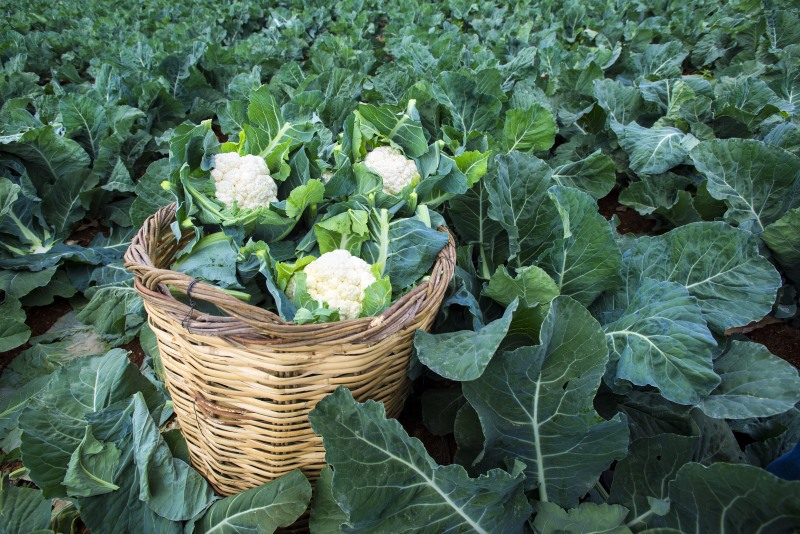
How Cauliflower Grows
Cauliflower needs a lot of water on a regular basis.
It does not mind wet leaves, so water heavily.
At recommended spacings, you should have a “living mulch” leaf canopy, but weed scrupulously.
Top-dressing the plants midseason with seaweed or fish fertilizer is a good idea.
Older cauliflower varieties required “blanching,”—which means having their leaves tied over the developing head to shield it from direct sun to preserve that desired white color.
Many modern cauliflower varieties “self-blanch,” meaning they fold their leaves over the head naturally.
In fact, all cauliflower varieties tend to do that.
It is just the habit of modern growers that has been encouraged in recent years.
The heads do become somewhat yellow, but this does not affect their taste.
If you are growing them in a container, remember to pay special attention to soil moisture.
Containers do not hold a lot of water.
Make sure to harvest before the heads start to “rice” and the curds start to loosen.
Cut a good bit of the stem along with the head.

Varieties
Ninety percent of cauliflower in grocery stores is the familiar pure white type.
Most cauliflower comes packed by size — 6, 9, 12, or 16 per case with size 16 is about five inches across.
Occasionally, the size will be as small as twenty per case.
Baby Cauliflower
As the name implies, baby cauliflower is a miniature version of regular cauliflower—only about two inches in diameter.
This variety is rare and more likely to be seen at 4-star restaurants than retail markets, even upscale ones.
Romanesco Cauliflower
Romanesco is a yellow-green cauliflower variety with spiraled florets that make it look like a headdress for a Siamese princess.
It has a milder flavor than regular cauliflower.
This variety can be found in specialty markets.
Broccoflower
Broccoflower is the brand name of a strain of cauliflower developed commercially by Tanimura & Antle Inc.
A California grower named Salinas first brought seeds to the United States from the Netherlands.
Broccoflower has the green color of broccoli all the way through.
It tastes like cauliflower though somewhat sweeter.
Other versions of green cauliflower are sometimes incorrectly called broccoflower.
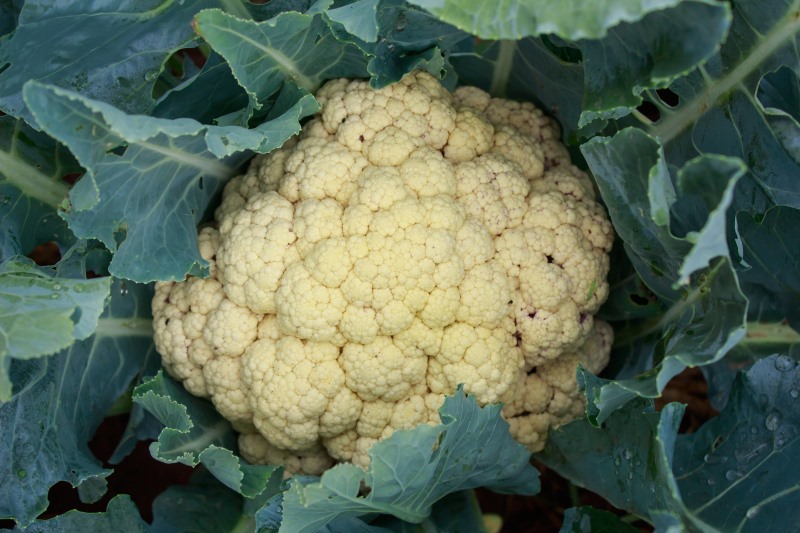
Interesting Facts
Cauliflower is a cruciferous vegetable that gets lots of love on the Internet but not on the dinner table.
It is often labeled a “superfood” because of its healthy attributes, but it is completely boring both to eat and to look at unless it is cooked creatively.
Here are a few interesting facts about cauliflower.
- Cauliflower is a descendant of wild cabbage. Today’s cauliflower is a close relative of wild cabbage. It used to look more like collard greens or kale but has evolved over time to look the way it does now.
- Cauliflower belongs to the family of Cruciferous vegetables. Cruciferous vegetables are so named because they have flowers with four petals that grow in the shape of a Greek cross.
- Cooking is harmful to the nutritional content of cauliflower. Prolonged cooking destroys most of the cauliflower’s vitamins and is linked with its sometimes bad, sulfur-like smell. Cooking for thirty or more minutes reduces the health benefits of cauliflower by 75%.
- Color of the head comes in different colors. Depending on the variety, cauliflower may come in different colors. The most common variety of cauliflower is white, but it can also be purchased in green, orange, purple, yellow, and brown.
- Cauliflower reminds you of a tree. The white head of cauliflower looks like a miniature tree on the cross-section. It has densely packed curds. The head is usually six inches wide, and large types weigh two to three pounds.
Nutritional Facts
According to the USDA National Nutrient Database, 100 g of cauliflower provides 25 calories, 1.9 g of protein, 0.3 g of fat, and 5 g of carbohydrates, including 2 g of fiber and 1.9 g of sugar (2).
Consuming 100 g of cauliflower provides 80% of your vitamin C daily needs, 20% of vitamin K, 10% or more of vitamin B6 and folate needs, as well as smaller amounts of thiamin, niacin, riboflavin, pantothenic acid, iron, calcium, phosphorus, magnesium, potassium, and manganese.
Health Benefits of Cauliflower
Cauliflower provides a royal health boost to everyone.
This versatile vegetable is not only low in calories but also packed with vitamins and minerals.
One cup of raw cauliflower is rich in antioxidant vitamin C, which is required for tissue growth and tissue repair in all parts of the body.
It is also necessary for the formation of the important protein collagen, which is used to make skin, tendons, ligaments, scar tissue, and blood vessels.
Cauliflower offers a healthy dose of fiber, potassium, folic acid, and also contains a sulfur compound isothiocyanate that promotes overall health and prevents disease.
Contains Glucosinolates
Besides numerous healthful compounds, cauliflower also has glucosinolates.
According to a study published in Molecular Nutrition & Food Research, these compounds are found in Brassica vegetables, and their activity has been linked with a reduced risk of colon and rectal cancer.
Essentially, glucosinolates act like natural pesticides in plant cells, but when consumed by humans, they help with changes in enzyme activities, DNA damage, and slowing the growth of mutated cancer cells (3).
During the chewing and digestion process, glucosinolates also break down into bioactive compounds, such as sulforaphane and isothiocyanates, called indole-3 carbinol.
During the process of chewing, glucosinolates are broken down into their active form, which triggers the detoxification process.
A study has shown that these compounds have antiestrogen and chemopreventive effects that prevent the growth of cancer cells (4).
This proves why cauliflower is an excellent way to prevent cancer (5).
Reduces Risk of Cancer
Numerous studies have shown a strong link between dieting and the risk of developing cancer.
This is because cauliflower has chemopreventive agents that stall early phases of cancer development to help shut off tumor growth.
For that reason, cauliflower can act as an anti-mutagen, thus effectively inhibiting the development of chemically induced carcinogenesis and halting tumor cells from further reproducing.
A review published in Advances in Experimental Medicine and Biology examined several studies and found that 64% of case-control studies showed an inverse association between high intake of one or more cruciferous vegetables and the risk of cancer at various sites (6).
One study conducted in China in 2013 demonstrated that cauliflower is particularly useful for preventing breast cancer (7).
A study published in Carcinogenesis found that sulforaphane may reduce the risk of chemically induced mammary tumors in animals (7).
Research has also shown that consumption of Brassica vegetables, such as cauliflower, assists in reducing the risk of various types of cancers (8).
Based on findings published in the International Journal for Vitamin and Nutrition Research, diets high in cruciferous vegetables are associated with a reduced risk of cancer, particularly lung and those of the gastrointestinal tract (9).
A study published online in 2010 showed a strong and significant inverse association between bladder cancer mortality and intake of Brassica vegetables (11).
A high intake of cauliflower has also been linked to a reduced risk of aggressive prostate cancer, particularly extraprostatic disease, according to the National Cancer Institute (11).
Finally, cauliflower may be associated with a reduced risk of ovarian and cervical cancer.
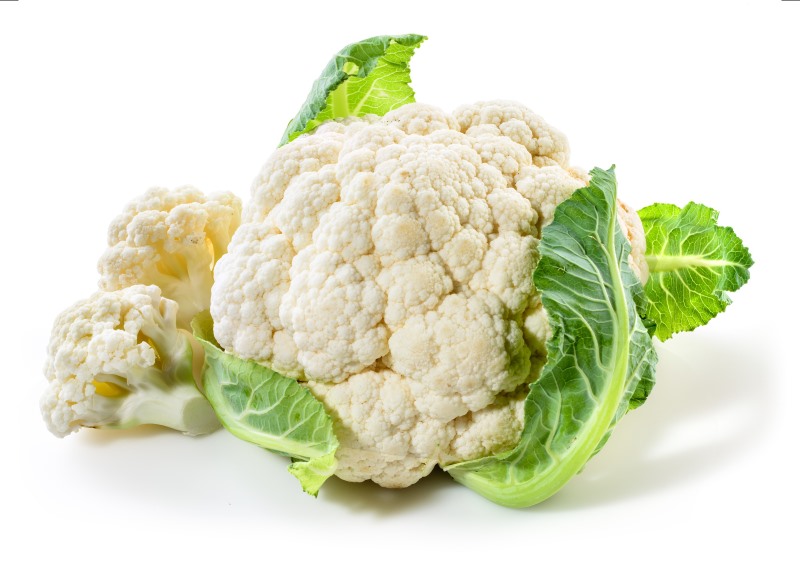
Contains High Amounts of Vitamin K
Cauliflower is also very rich in vitamin K, which is important for bone development, helping your bone cells produce collagen required for the formation of new mineralized bone tissue (12).
The primary role of vitamin K involves clot formation.
Vitamin K is one of several components important for the coagulation cascade, which is the series of chemical reactions necessary for stimulating the formation of a blood clot.
Individuals who are deficient in vitamin K bleed excessively after injury and develop spontaneous bleeding and bruising because a low intake of vitamin K prevents proper clot formation (13).
People who lack vitamin K are exposed to an increased risk of osteoporosis, atherosclerosis, and cancer as well as age-related diseases (14).
One cup of chopped cauliflower contains 16.6 mcg of vitamin K.
Boosts Cardiovascular Health
Cauliflower contains decent amounts of vitamin K, which has anti-inflammatory properties.
According to the Linus Pauling Institute of Oregon State University, vitamin K is an important nutrient for blood clotting, and vitamin K deficiency can cause hemorrhages (15).
Vitamin K might also decrease the risk of heart disease, but a lack of vitamin K does not trigger the mechanisms that stop the formation of blood vessel calcification.
Studies are still inconclusive, however, regarding any possible detrimental effects of vitamin K deficiency, but one review published in the Journal of Advances in Nutrition suggested that future research should focus specifically on patients deficient in vitamin K (16).
Regular consumption of cauliflower leads to healthy blood circulation and aids in maintaining blood vessels, which can be attributed to the presence of sulforaphane.
A 2015 review published in Oxidative Medicine and Cellular Longevity suggested that anti-inflammatory activities of sulforaphane may help protect against hypertension, stroke, atherosclerosis, and myocardial infarction (17).
Another compound found in cauliflower helps maintain cardiovascular health.
It is called glucoraphanin, the natural precursor to sulforaphane that is converted to isothiocyanates, which promote anti-inflammatory activities and prevent the accumulation of lipids in the blood vessels.
This promotes unobstructed blood flow, thereby reducing the risk of such conditions as atherosclerosis and promoting cardiovascular health (18).
One more component in cauliflower functions at the genetic level and prevents inflammation at an early stage.
Namely, isothiocyanate, indole-3-carbinol, or I3C is an anti-inflammatory component that has been proven to be effective in the synthesis of lipids, cholesterol, level of triglycerides, and in maintaining cardiovascular health.
According to a 2007 review published in the Journal of Nutrition, indoles have beneficial effects on lipid synthesis, which could contribute to their potential cardioprotective effect (19).
Besides indoles, Phytotherapy Research showed in a 2008 study that the antiplatelet and anti-thrombotic function of indole-3-carbinol contributes significantly to a healthy heart (20).
The Journal of the American College of Cardiology has detailed results showing that the omega-3 fatty acids present in the form of alpha-linolenic acids in cauliflower also contribute to this beneficial activity (21).
Rich in Vitamin C
Your body needs vitamin C to maintain a range of tissues.
If you are vitamin C deficient, your body will not be able to produce the structural protein collagen, leading to a breakdown of your blood vessels, teeth, bone, and skin tissue (22).
Diets high in vitamin C might also help reduce the risk of heart disease, according to a review in the European Journal of Cardiovascular Prevention and Rehabilitation (23).
Cruciferous vegetables, including cauliflower, have been reported to constitute an important source of dietary vitamin C (24).
Adult men and women require 90 and 75 mg of vitamin C, respectively.
One cup of chopped cauliflower contains 51.6 mg of vitamin C.
Builds Stronger Bones
Cauliflower is an abundant source of vitamin C, which is important in the production of collagen.
Collagen protects bones and joints from inflammatory damage.
In 2000, the Division of Rheumatic Diseases of the University of Cleveland reviewed the function of collagen in treating osteoarthritis and osteoporosis.
It has been suggested that collagen may have therapeutical effects in treating osteoarthritis and osteoporosis (25).
The Journal of the American Podiatric Medical Association conducted an animal study in 1990 to determine if vitamin C is effective for treating patients with rheumatoid arthritis.
Further evidence is needed (26).
Also, low intakes of vitamin K have been linked with an increased risk of bone fracture and osteoporosis.
The medical center at the University of Maryland suggests that vitamin K aids in preventing bone loss in both men and women (27).
Adequate consumption of vitamin K improves bone health by functioning as a modifier of bone matrix proteins.
A 2003 study conducted by the Department of Sports Medicine in Japan suggests that vitamin K stimulates intestinal calcium absorption and reduces urinary excretion of calcium (28).
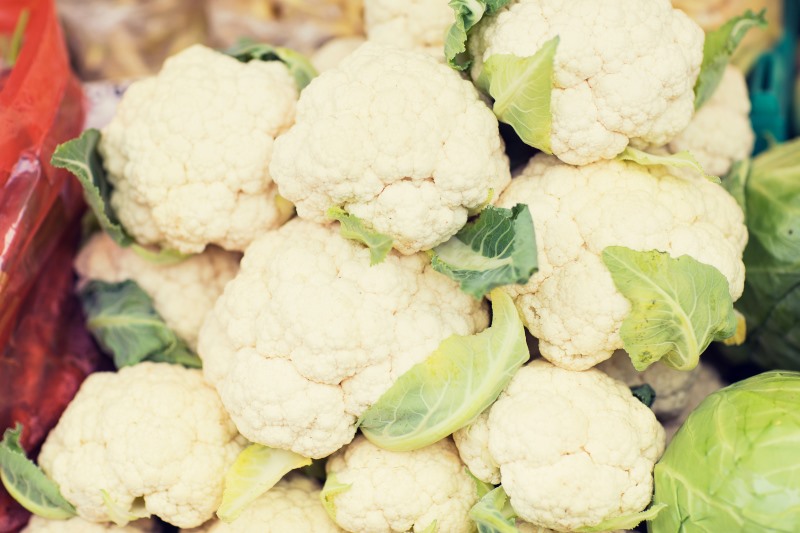
Fights Inflammation
Inflammation is at the heart of nearly all chronic disease common today.
To stay healthy, your body needs some level of inflammation, but it is possible and increasingly common for the inflammatory response to get out of hand.
Your immune system may mistakenly trigger an inflammatory response when no threat is present.
It can cause significant inflammation-related damage to your body, a condition associated with cancer and other diseases, depending on which organs the inflammation is affecting.
Cauliflower contains many anti-inflammatory nutrients to help keep inflammation in check, including indole-3-carbinol.
A recent study also suggests that indole-3-carbinol exerts anti-fibrosis, anti-tumor, antioxidant, immunomodulatory, detoxification, and anti-inflammation effects in patients with hepatitis (29).
An animal study published online in 2011 suggested that mice fed high-fat diets in controlled conditions were reported to experience suppression of inflammation-associated factors by indole-3-carbinol (30).
Likewise, cauliflower is high in other anti-inflammatory compounds that lower oxidative stress and the presence of free radicals in your body.
Beta-cryptoxanthin, beta-carotene, caffeic acid, ferulic acid, cinnamic acid, quercetin, kaempferol, and rutin are antioxidants found in cauliflower that help reduce oxidative stress in your body, which, when left unregulated, can cause cancer and various other conditions.
Just one cup of cauliflower contains at least 73% or more of the recommended daily value of vitamin C, thus reducing inflammation, boosting immunity, and keeping the body free of harmful bacteria, common colds, and infections.
Boosts Brain Health
Cauliflower is a good source of choline, a B vitamin that is essential for brain development (31).
It is a very important and versatile nutrient that together with phosphorus helps to repair cell membranes and improves sleep, learning, muscle movement, and memory.
Choline also helps in maintaining the structure of cellular membranes, assisting in fat absorption and the transmission of nerve impulses, and reducing chronic inflammation.
In addition, the presence of vitamin B6 and potassium in cauliflower is also important for maintaining brain health and promoting proper communication in the nerves by producing a range of required neurotransmitters, including norepinephrine and dopamine.
According to a 2004 review published in the Journal of Neurophysiology, the presence of choline during pregnancy stimulates the brain activity of animals in utero, indicating that it can boost cognitive function and improve memory and learning (32).
It may even diminish age-related memory decline as well as your brain’s vulnerability to toxins during childhood.
Cauliflower is also rich in vitamin K, which has been proven to improve brain function.
A review published in BioFactors suggests that vitamin K has the potential to influence psychomotor behavior and cognition (33).
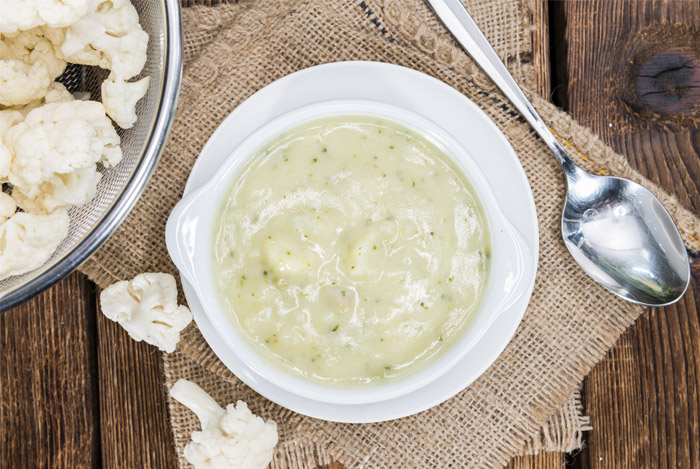
Supports Detoxification
Adding cruciferous vegetables to your diet is extremely important for your body’s detoxification system.
Cauliflower contains indole-3-carbinol, a phytonutrient that along with sulforaphane helps activate and regulate the function of detoxifying enzymes.
These nutrients are important for Phase I detoxification along with sulfur-containing nutrients essential for Phase II detox activities.
Other compounds found in cauliflower—glucobrassicin, glucoraphanin, and gluconasturtiin—are very important for helping the body detox due to their function to support the liver.
These compounds stimulate what is known as Phase II enzymes, the natural antioxidant system of your body.
They help trigger the liver to produce detoxifying enzymes that block free radical damage (34).
Improves Digestion
Cauliflower is rich in both fiber and water content, which helps prevent constipation, maintain a healthy digestive tract, and lower the risk of colon cancer.
Adequate fiber intake promotes regularity, which is essential for the daily excretion of toxins through bile and stools.
A 1995 study has shown that dietary fiber increases the frequency of bowel movements and may prove to be beneficial in treating constipation, a common childhood disorder (35).
Additionally, a recent study conducted by the Department of Food Engineering in Turkey has found that dietary fiber is important for preventing gastrointestinal diseases, hemorrhoids, constipation, gastroesophageal reflux disease, colon cancer, duodenal ulcer, diverticulitis, obesity, stroke, diabetes, hypertension, and cardiovascular diseases (36).
To support their claim, the Department of Internal Medicine and Nutritional Sciences Program of the University of Kentucky published a 2009 review associating high fiber intake with a significantly lower risk of developing coronary heart disease, hypertension, stroke, diabetes, obesity, and certain gastrointestinal diseases (37).
Glucosinolate can also aid in protecting the vulnerable lining of the stomach, decreasing the risk of developing leaky gut syndrome or other digestive disorders.
At the same time, sulforaphane stimulates detoxification and digestion by preventing bacterial overgrowth occurring in the gut microflora, preventing bad bacteria from overwhelming the digestive system and allowing good bacteria to thrive.
The Journal of Nutrition published a 2009 study showing that consumption of cruciferous vegetables, including cauliflower, alters human gut bacterial communities, thus improving digestion (38).
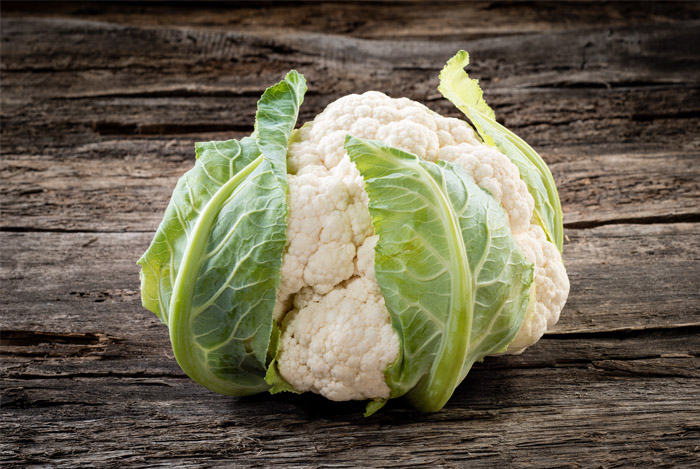
Contains Antioxidant Power
Consuming cauliflower is like winning the antioxidant and phytonutrient lottery.
Antioxidants provide your cells with adequate defense mechanisms against attack by reactive oxygen species.
According to a 2010 article in Pharmacognosy Review, antioxidants are molecules that safely interact with free radicals to help relieve oxidative stress (39).
Consumption of these important micronutrients will help your body resist aging caused by everyday exposure to chronic stress, pollutants, and more.
Otherwise, you will be at risk of oxidative stress, which causes accelerated tissue and organ damage.
Thanks to a high content of vitamin C, vitamin K, and manganese found in cauliflower, the risk of oxidative stress is lowered.
These three antioxidants help keep the body healthy because they help prevent such conditions as cancer, arthritis, and heart disease by preventing free radicals to cause cell damage and disruption.
One cup of cooked cauliflower contains 73% of the recommended daily value of vitamin C, 19% of the recommended daily value of vitamin K, and 8% of the recommended daily value of manganese.
Helps Pregnancy
Adding cauliflower to your diet is beneficial during pregnancy due to the presence of essential folate, which helps prevent neural tube effects, such as spina bifida, in the fetus, according to the Centers for Disease Control and Prevention (40).
According to the Linus Pauling Institute at Oregon State University, choline may also help in this regard, even though studies are inconclusive (41).
One cup of cooked cauliflower provides 11% of choline daily needs.
Cauliflower also has other essential vitamins and minerals, including fiber, which facilitates pregnancy and promotes overall health.
Protects against Ultraviolet Radiation
According to findings of the Proceedings of the National Academy of Sciences of the United States of America, sulforaphane present in cauliflower is beneficial for protecting the skin against damage caused by ultraviolet radiation (UVR) (42).
Sulforaphane defends your body against inflammation, skin cancer, cellular damage, and UV-induced erythema (43).
Vitamin C is also important in wound healing due to its capacity to synthesize collagen.
A study published in the British Journal of Community Nursing found that vitamin C is essential throughout the wound healing process as well as for healthy skin and hair (44).
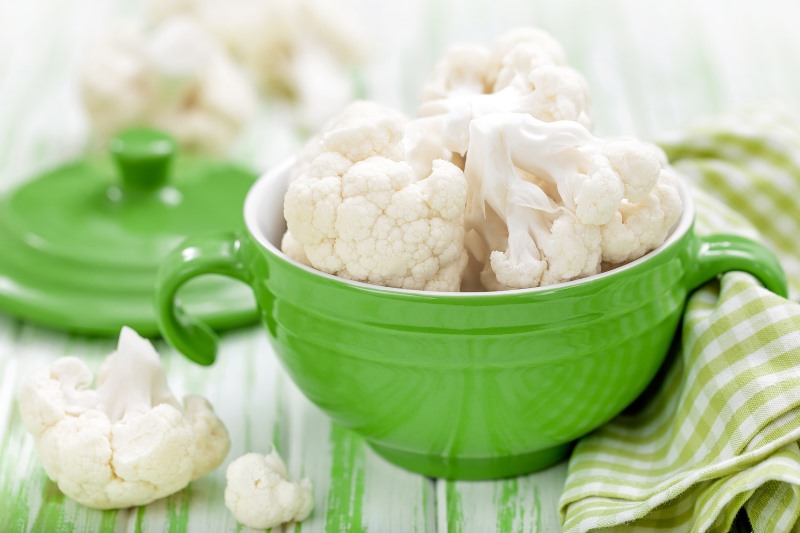
Cauliflower Promotes Iron Absorption
Cauliflower is also a good way to boost iron absorption in your body because of its high content of vitamin C.
Vitamin C is necessary for overcoming the effects of phytonutrients that inhibit iron absorption, as well as releasing iron from non-heme sources, such as fruits, vegetables, and nuts.
These foods are less likely to absorb iron than such foods as meats, which are heme sources.
According to the International Journal for Vitamin and Nutrition Research, ascorbic acid, also known as vitamin C, promotes iron absorption because it prevents the formation of insoluble and unabsorbable iron compounds and reduces ferric to ferrous iron (45).
A 1980 review published in the Annals of the New York Academy of Sciences suggests that the enhancement of iron absorption from vegetable meals is directly proportional to the quantity of ascorbic acid present (46).
Aids In Weight Loss
Cauliflower contains only twenty-nine calories per cup and has virtually zero grams of fat, very low levels of carbohydrates and sugar, but yet is high in volume and filling fiber.
This makes cauliflower an excellent choice for those trying to lose weight, since eating cauliflower will fill you up without consuming too many calories, sugar, fat, or carbohydrates.
Cauliflower also stimulates bowel movement and reduces constipation, keeping excess waste or water moving out of your body.
Cauliflower contains such components as indoles, which have anti-obesity properties.
The Journal of Nutritional Biochemistry published a 2012 study indicating that consumption of cauliflower is beneficial in preventing various metabolic and inflammation disorders in the body as well as in helping the stimulation of fat-burning thermogenesis and preventing obesity (47).

Helps Balance Hormones
Diets rich in whole foods and antioxidant-filled vegetables, such as cauliflower, have been shown to help partially balance hormones by reducing unhealthy levels of estrogen.
Research has shown that ¼ cup to 1 cup of cruciferous vegetables can create profound health improvement resulting from rebalancing estrogen levels.
Foods high in estrogen can be harmful to your health when they begin to destroy the vulnerable hormonal balance.
A poor diet and unhealthy lifestyle make hormonal imbalance very common.
Processed foods, such as meat, dairy, soy, yeast, and those that are refined, can all cause an unhealthy level of estrogen in your body.
Too much estrogen in the bloodstream is linked with such health issues as hypothyroidism, chronic fatigue, autoimmune disease, and ovarian cancer.
In 1997, the Journal of the National Cancer Institute published a study suggesting that diets high in indole-3-carbinol significantly increase the urinary excretion of estrogen (48).
This greatly contributes to a hormonal balance that affects many people.
Researchers from Nutrition and Cancer demonstrated a strong association between estrogen metabolism and the incidence of breast cancer.
Namely, balanced estrogen metabolism provides a reduced risk of cancer (49).
Boosts Eye Health
Cauliflower is high in vitamin C and antioxidants, which have been shown to reduce the risk of age-related macular degeneration, which can cause blindness, particularly in the elderly.
According to a 2013 study, the results of a five-year trial suggest that vitamin C, beta-carotene, and zinc have positive long-term effects on age-related macular degeneration (50).
Sulforaphane, another compound found in cauliflower, has been shown to protect retinal tissues from damage caused by oxidative stress as well as from vision impairment and various eye ailments, such as cataracts.
A 2008 review published in Investigative Ophthalmology & Visual Science suggested that sulforaphane potentially treats macular degeneration and diseases in which oxidative injury may be significant (51).
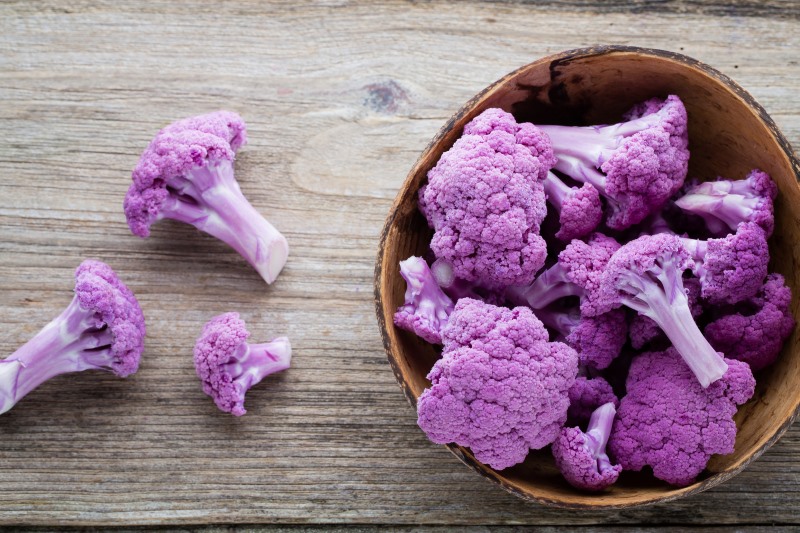
Prevents Stomach Disorders
Cauliflower is a great source of dietary fiber that stimulates digestion and promotes the elimination of toxins from your body.
The presence of glucoraphanin, glucosinolate, and sulforaphane in cauliflower protects the stomach lining and aids in resisting the growth of Heliobacter pylori bacteria, according to the research conducted by Proceedings of the National Academy of Sciences of the United States of America (52).
The book Change Your Diet, Change Your Health by Jorge Bordenave notes that sulforaphane prevents overgrowth of the bacterium Helicobacter pylori, which are the bacteria responsible for causing gastric ulcers and gastric reflux (53).
Dietary isothiocyanates found in cauliflower have been shown to prevent the risk of various abdominal disorders, such as stomach ulcers and colon cancer, according to Cancer Research (54).
Fights Respiratory Diseases
Cauliflower contains indole-3-carbinol, which is effective in treating respiratory diseases, specifically recurrent respiratory papillomatosis.
Respiratory papillomatosis is a condition caused by the human papillomavirus that has an effect on the vocal cords in the larynx, bronchi, trachea, and lungs (55).
The Official Journal of American Academy of Otolaryngology published a 1998 review suggesting that indole-3-carbinol may be effective in treating recurrent respiratory papillomatosis (56).
Another study concluded that consumption of cruciferous vegetables may be a successful treatment option for recurrent respiratory disease, but further evidence is needed regarding its effectiveness in treating children (57).
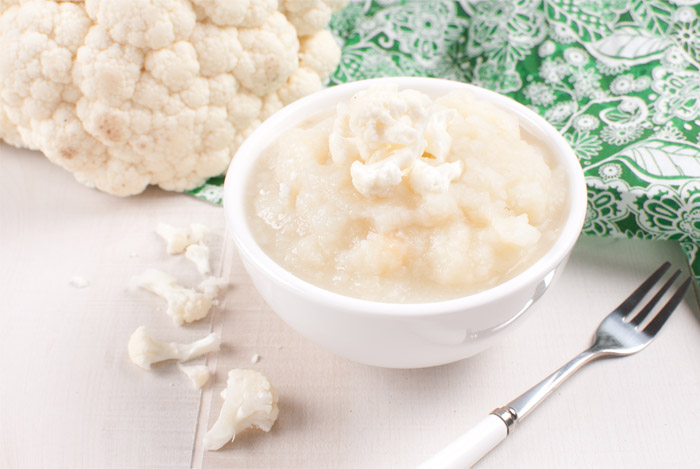
Fights Neurodegenerative Disorders
Indoles and sulforaphane, compounds found in cauliflower, help reduce the progression of neurodegenerative diseases.
They also activate the detoxification enzymes, which raises the levels of glutathione and helps in treating the neuronal injuries caused by oxidative stress and inflammation in Alzheimer’s and Parkinson’s disease.
The journal Frontiers in Aging Neuroscience published a 2011 study that found that a higher intake of foods rich in vitamin E, including cauliflower, may modestly reduce the long-term risk of dementia and Alzheimer’s disease (58).
In 2014, the same journal published a study suggesting that cruciferous vegetables rich in antioxidants are a group of vegetables with neuroprotective capacity, thus reducing the risk of Parkinson’s disease (59).
Lowers Cholesterol
Cauliflower is one of many foods rich in plant sterols also known as phytosterols.
These help keep cholesterol numbers down by blocking the absorption of cholesterol in the intestines.
According to the Current Opinion in Lipidology and their 2004 study, foods rich in phytosterols effectively decrease the levels of LDL-cholesterol when given as supplements. In addition, smaller amounts of phytonutrients in natural foods have also been shown to be important (60).
Cauliflower is also high in vitamin C, manganese, and the inflammation-fighting compounds vitamin K and omega-3 fatty acids, which aid in reducing bad cholesterol and prevent hardening of the arteries.
Contains Potassium
Potassium is a mineral that regulates heart and muscle function.
Potassium has been shown to lower blood pressure in individuals with both average population blood pressure and raised blood pressure (61).
Potassium is also beneficial for reducing the risk of stroke and coronary heart disease (62).
Being a major electrolyte substance, potassium can also regulate electrolyte balance.

Lowers Blood Pressure Levels
Sulforaphane, a compound found in cauliflower, has been found to lower blood pressure.
A 2012 study published in the American Journal of Hypertension discovered that sulforaphane can also normalize kidney function and significantly reduce blood pressure (63).
A study published in International Scholarly Research Notices Pharmacology demonstrated the benefits of sulforaphane in lowering blood pressure.
The researchers used spontaneously hypertensive rats that were treated with sulforaphane. After eight weeks, higher doses of sulforaphane significantly reduced their blood pressure (64).
Reduces Risk of Stroke
Besides its potassium content, cauliflower also contains the compound allicin, which helps to cleanse the liver and blood.
A study published in the Journal of the American Heart Association in 2011 suggests that eating white flesh fruits and vegetables, such as cauliflower, reduces the risk of stroke due to the presence of beneficial phytochemicals, including allicin (65).
According to the Journal of Nutrition, Metabolism, and Cardiovascular Disease, increased consumption of potassium-rich foods is effective in reducing the risk of stroke (66).
Regulates Electrolyte Balance
Cauliflower contains potassium, which is one of the major electrolyte substances in your body. It is also important in maintaining homeostasis, which is the process carried out by the human body to maintain a constant temperature (63).
The content of potassium in cauliflower helps maintain the electrolyte balance in the body, which is essential for the function of the nervous system in the transmission of muscle contractions and nerve impulses.
Potassium-deficient individuals have an increased risk of stroke, enhanced salt sensitivity, but diets rich in potassium have the capacity of modulating electrolyte balance according to a 2015 study published in the Journal of Cell Metabolism (64).
Strengthens Immune System
Cauliflower is high in antioxidants and immune-strengthening nutrients.
The presence of vitamin C in cauliflower stimulates the production of lymphocytes, an essential element of the immune system.
Also, ascorbic acid is required by the thymus gland, which appears to be an important component of the immune system (65).
Based on the findings reviewed by the Annals of Nutrition and Metabolism, supplementation of vitamin C was found to improve the human immune system and help protect against malaria, pneumonia, and diarrhea infections (66).
Cauliflower is also high in selenium, a trace mineral that strengthens the immune system and prevents cancer (67).
Reduces Risk of Diabetes
Regular consumption of cauliflower reduces the risk of diabetes due to the presence of potassium and vitamin C.
According to the Expert Review of Endocrinology & Metabolism, lower levels of potassium have been found to be associated with a higher risk of diabetes (68).
The potassium content in cauliflower along with sodium helps in regulating glucose metabolism (69).
The pancreas utilizes potassium for secreting the insulin hormone to take action against elevated blood sugar levels in the body.
Diets low in potassium can eventually raise blood sugar levels and pose a major threat for diabetics (70).
Additionally, vitamin B6 found in cauliflower is also beneficial for enhancing glucose tolerance in patients with gestational diabetes, which is a type of diabetes developed during pregnancy (71).
Prevents Colitis
Due to anti-inflammatory properties of cauliflower, this superfood exerts beneficial effects on inflammatory bowel disease, particularly ulcerative colitis.
According to South Dakota State University and their study from 2010, extracts from cruciferous vegetables were effective in alleviating signs of ulcerative colitis in mice (72).
The protective effect of cauliflower can be attributed to the presence of phenylisothiocyanate, which repairs damage in colon tissues and the colon epithelium.
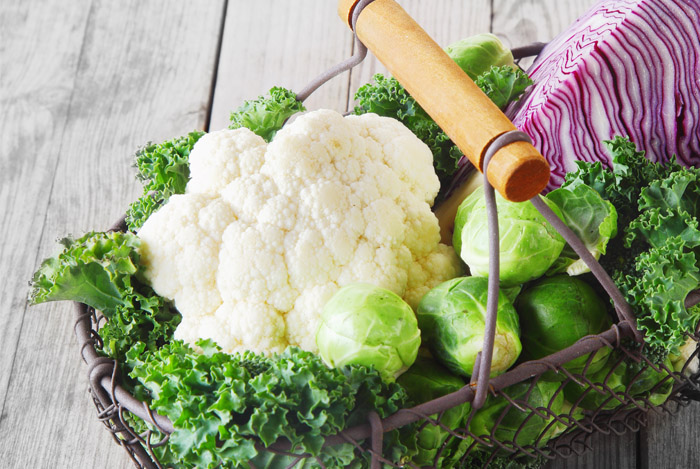
How to Buy and Store
When choosing cauliflower at the grocery store or farmers market, you want to be sure you are selecting a head that is as fresh as possible.
Buying
- Look for cauliflower that has a creamy white color with densely packed florets that are free of browning, blemishes, or wet spots. The cauliflower head should feel heavy in your hand for its size.
- Pay special attention to the leaves. They should be vibrant and fresh, which is an indication that the cauliflower was recently harvested.
- If buying green, orange, or purple cauliflower, it should be uniformly colored.
- Pay special attention to the odor. If the cauliflower has a strong smell, it is past its prime and will probably have an unpleasant taste.
Storing
- Most grocery stores wrap cauliflower tightly in cellophane, which can trap moisture and promote rot. When you return home, unwrap it right away and transfer it to a loosely sealed plastic bag, with a paper towel tucked in to absorb any excess moisture.
- You can keep whole heads of cauliflower in a loosely sealed plastic bag in the refrigerator for four to seven days. Precut florets should be stored for no more than four days.
Preparing
- To cut a head of cauliflower into florets, you need to quarter the head through the stem end and cut away the small piece of core from each quarter. Then cut the cored cauliflower into bite-sized florets.
- Do not toss the leaves and stalk. They are edible and tasty, so you may want to use them in your cooking. Peel and cut the stalks so that they are about the same size as the florets to ensure even cooking.
- Rinse the pieces in a colander to remove any residual dirt. Use a paper towel or clean kitchen towel to pat them dry before cooking.
How to Incorporate More Into Your Diet
Cauliflower is most commonly found fresh or frozen.
When picking out fresh cauliflower, look for a firm head with no dark spots and bright green leaves attached to the stem.
New and trendy ways to add cauliflower to your diet include cauliflower crust pizza, buffalo cauliflower “wings,” and cauliflower “rice.”
Some Simple Recipes
Serve up this superfood in one of these quick side dish recipes:
Roasted Cauliflower Salad With Feta
Toss cauliflower florets with olive oil, pepper, and salt and roast at 400° F until tender.
Afterward, let it cool.
Serve on salad greens with sliced red onion, chopped almonds crumbled Feta, and your favorite vinaigrette.
Cauliflower With Raisins and Pine Nuts
Sauté cauliflower florets and sliced garlic in olive oil until browned and tender.
Toss with pine nuts, golden raisins, crushed red pepper, and salt.
Cauliflower, Bacon, and Olive Pasta
Cook bacon that is cut up until crisp.
Afterward, remove it from the skillet.
Add cauliflower florets and cook until browned and tender.
Toss with cooked penne, grated Parmesan pitted kalamata olives, and chopped parsley.
Cauliflower Puree
Steam cauliflower florets until very tender.
Puree with butter.
Season with salt and pepper.
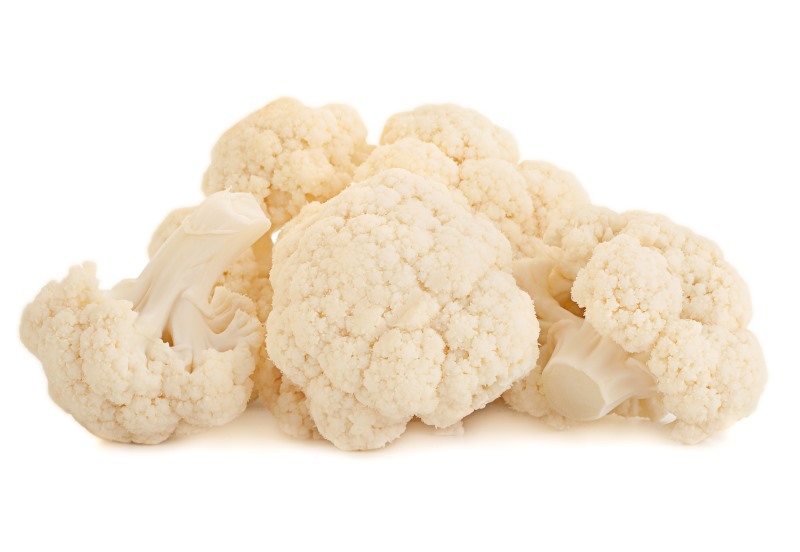
Precautions
You should be careful when eating cauliflower if you are taking certain medications.
Drug Interactions
Cauliflower is a rich source of vitamin K, which is utilized by the body for normal blood clotting.
Vitamin K can interact and decrease the effectiveness of anticoagulants, such as coumadin and warfarin, which are prescribed to prevent blood clotting in the body (73).
If taking anticoagulant medications, it is always recommended to discuss the dietary intake of foods high in vitamin K, such as cauliflower, with a health professional.
Side Effects
The risks of eating cauliflower are generally minimal, but like other cruciferous vegetables, cauliflower can make you bloated or gassy.
Gas
Cauliflower contains complex carbohydrates that do not get broken down entirely in the digestive tract (74).
These carbohydrates are fed upon by intestinal bacteria, which sometimes can result in bloating and the release of odorous gas, such as carbon dioxide and hydrogen.
Purines
Cauliflower contains purines, which can lead to various health conditions if consumed in excess (75).
Purines break down to form uric acid, and the excessive intake of foods rich in purine can cause a buildup of uric acid in the body (76).
This can lead to uric acid–related problems, such as gout and kidney stones.
People with such complications should limit their intake of purine-rich foods, such as cauliflower.
Anaphylaxis
Cauliflower may cause anaphylaxis in some people, meaning a severe allergic reaction to a substance (77).
Warning signs of such allergic reactions include itching, swelling of certain body parts, dyspnea, and breathing complications.
It is always recommended to stop eating cauliflower if such critical symptoms occur and seek medical attention.
Conclusion
Cauliflower contains a wealth of fiber and choline, along with powerful phytochemical compounds indole-3-carbinol and isothiocyanates.
It is also high in vitamin C and vitamin K.
These health-promoting nutrients make incorporating cauliflower into your daily diet a smart strategy to protect against cancer, heart disease, diabetes, and many other major and minor health conditions.
FDA Compliance
The information on this website has not been evaluated by the Food & Drug Administration or any other medical body. We do not aim to diagnose, treat, cure or prevent any illness or disease. Information is shared for educational purposes only. You must consult your doctor before acting on any content on this website, especially if you are pregnant, nursing, taking medication, or have a medical condition.
HOW WOULD YOU RATE THIS ARTICLE?
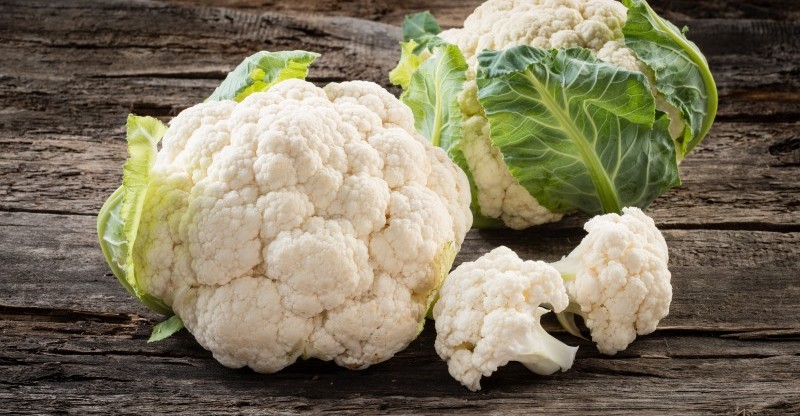






I’m crazy about cauliflower and I like it cooked. But I wonder if it still helps to balance hormones when it’s cooked. Or it is better to have it raw??!!!
Hello Shelly! Cauliflower keeps its benefits even when it’s cooked, but it’s advised to give preference to boiling and steaming.
Awesome guide about one of my favourite vegetables.
Thank you! I did my best to cover cauliflower health benefits theme 🙂
Can cauliflower promote conception due to its estrogen controlling benefits?
Nice article, thank for sharing it!
Sometimes I suffer from bloating, how do you think what amount of cauliflower will be good for me?
You write that cauliflower can prevent diabetes. Is it beneficial for those who already live with this disease?
Great and informative. Thank you.
Well-done. Great piece. U took ur time to explain from benefits to everything one needs to know
I enjoy it minimally cooked but raw is even better and no seasonings, which includes no salt. It is refreshing to eat simply as it is.
(TMI: I had a dream that I should eat more cauliflower) This sounds like a SUPER FOOD. I love cauliflower, so it will not be a hardship to add this to my diet.